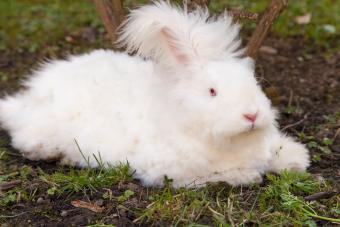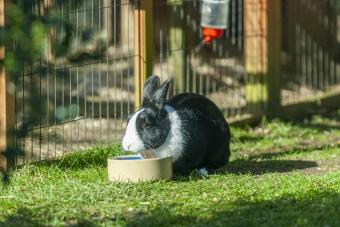
MediaNews Group/Orange County Register via Getty Images /MediaNews Group / Getty Editorial Use Getty Images license - Getty Editorial Use Flemish giant rabbit
If you believe bigger is better, you should check out big rabbit breeds. Some giant rabbits make excellent pets because of their docile natures, while others require careful handling. The American Rabbit Breeders Association (ARBA) recognizes a variety of large breeds, and each has its own charm.
Flemish Giant Is the World's Largest Rabbit Breed
Called the "king of rabbits" due to their massive size, the Flemish Giant is the largest known rabbit breed. The breed is thought to have originated from stone rabbits in the old Flemish region. According to the National Federation of Flemish Giant Rabbit Breeders (NFFGRB), Flemish Giants typically reach an adult size of 14 pounds. However, this breed has been known to hit weights as high as 50 pounds.
- One of the largest Flemish Giant rabbits recorded is Darius. Darius is owned by U.K. breeder Annette Edwards and weighs in at a whopping 50 pounds. He's also the lengthiest known living rabbit at 4 feet and 3 inches long.
- The NFFGRB recognizes seven unique colors of Flemish Giants.
- Flemish rabbits are a hardy breed and can live up to 10 years.
- This breed is gentle and docile if socialized at a young age.
- Flemish Giants can make excellent pets as well as show rabbits.
Checkered Giant Rabbit Is a Huge Rabbit
According to the American Checkered Giant Rabbit Club, this large breed should have both a long body and lengthy legs. The origin of this breed is unknown. However, some people believe the breed originated from a cross between a Flemish Giant and a Lop. Giant Checkered rabbits are also called Giant Papillons in the United Kingdom.

- The color pattern of the Checkered Giant is unique, with a white coat and black or blue markings. They have circles around the eyes, a butterfly on the nose, and a strip of dark fur down the spine.
- Checkered Giants can reach 8 years of age if cared for properly.
- The average Checkered Giant weighs 11 pounds for males (known as bucks) and 12 pounds for females (referred to as does).
- Although Checkereds are large rabbits, they don't quite measure up to the Flemish Giant or the French Lop and have not broken any known records.
- The breed is known to bite and has a nervous temperament, although each individual rabbit has a unique personality.
- It is best to use an experienced handler if you plan to show this breed.
Giant Angora Are Big Rabbits
According to the National Angora Rabbit Breeders Club (NARBC), in order for this breed to be considered "Giant," they must reach at least nine and a half pounds for senior bucks and 10 pounds for senior does. This gorgeous, show-stopping animal has long white fur and pink eyes. Angora rabbit fur is incredibly luxurious and can be spun into wool for use in clothing or decorative items.

- The breed originated in Turkey in the area called Anakara, or sometimes called Angora. They were kept by French Royalty in the 1700s so that they could weave angora wool from the fur.
- These rabbits are generally calm and easy-going.
- They resemble puffs of white fur with a face peering out, and they have large, floppy ears.
- Giant Angora rabbits can live up to 11 years of age.
- The coat has three different types of fur. The Giant and German are the only Angora breeds to have awn hair.
- Out of the recognized Angora breeds, the Giant is the largest.
Giant Chinchilla
According to the Giant Chinchilla Rabbit Association, the Giant Chinchilla is one of only a few breeds developed in the United States. The breed was created by Edward H. Stahl and dates back to 1921. The unique coloring of the Giant Chinchilla rabbit's fur resembles that of a chinchilla, hence their name.

- Million Dollar Princess was the first Giant Chinchilla doe born. She was a cross between a Standard Chinchilla and a Flemish.
- A grown buck weighs 12 to 15 pounds, and a grown doe weighs 13 to 16 pounds. These rabbits can reach a lifespan of 8 to 9 years.
- These rabbits are known for their commercial qualities and are often used as meat. This factor is considered in judging.
- Giant Chinchillas are gentle and have a sweet nature.
- Their litters can easily consist of six to eight babies.
French Lop
The French Lop's history is clear in its name. According to the Lop Rabbit Club of America, the breed hails from France, where it was developed in the 1800s by crossing an English Lop and a Butterfly rabbit.

- This breed comes in a variety of colors and has dense, soft fur.
- Both buck and doe French Lops weigh about 10 to 15 pounds.
- This rabbit has a short, heavy frame and medium-length ears that hang down on either side of their head.
- They are an intelligent breed and tend to be good-tempered and tolerant of children.
- The lifespan of a French Lop is about 5 to 7 years with proper care.
- They like company, so it's best to keep them in pairs.
Care Requirements for Giant Rabbit Breeds
Given their large size, giant rabbits have a few additional upkeep needs. Even if you're familiar with caring for a traditional-sized rabbit, it's important to understand the unique requirements for these massive pets.
- The main health issue to be aware of with giant rabbits is sore hocks or pododermatitis due to their heavy weight. Keeping your bunny at a healthy weight can help reduce this concern. Always provide them with cushioned bedding to prevent these pressure sores.
- Flemish Giants and Chinchilla Giants, among many of the other large rabbit breeds, are more sensitive to heat than their smaller cousins.
- Because big breeds can reach up to 4 feet long when they stand or stretch out, these rabbits require larger enclosures. Your bunny's accommodation should be at least 12 feet wide in any direction or accommodate 3 consecutive hops.
- Giant rabbits can be slightly awkward to hold and carry because of their size. It's important to understand how to safely handle a rabbit to prevent injury to their spine and prevent injury to you from scratches or bites. Checkered Giants, in particular, can become jumpy and bite.
-
Due to their long fur and personal grooming habits, Angoras are prone to hairballs, sometimes referred to as a wool block. Rabbits don't have the ability to vomit, so they can't expel hairballs the way cats can. If left untreated, these clumps of fur can lead to gastrointestinal stasis or complete obstruction of the intestines. Be sure to regularly groom your rabbit and feed them a healthy diet to prevent digestive problems.
How to Find a Giant Rabbit
You can take a few different routes if you'd like to acquire a giant rabbit as a pet or to show. Animal shelters and adoption rescues are great places to locate rabbits in need of a home. They often have giant varieties who have been relinquished because their owners may not have realized the extent of their care. The House Rabbit Society is an excellent resource, as is Petfinder.
If you'd prefer a baby giant bunny or would like to get a show-quality rabbit, you can find a list of reputable breeders through the American Rabbit Breeders Association.
Choosing the Biggest Bunny Breeds
Now that you know a little more about some of the giant rabbit breeds, you should have a better idea of whether one of these big bunny breeds is right for you. Although the majority of ARBA-recognized breeds are listed, you could also consider other varieties of giant rabbits, such as the German Giant, British Giant, or the Spanish Giant.







